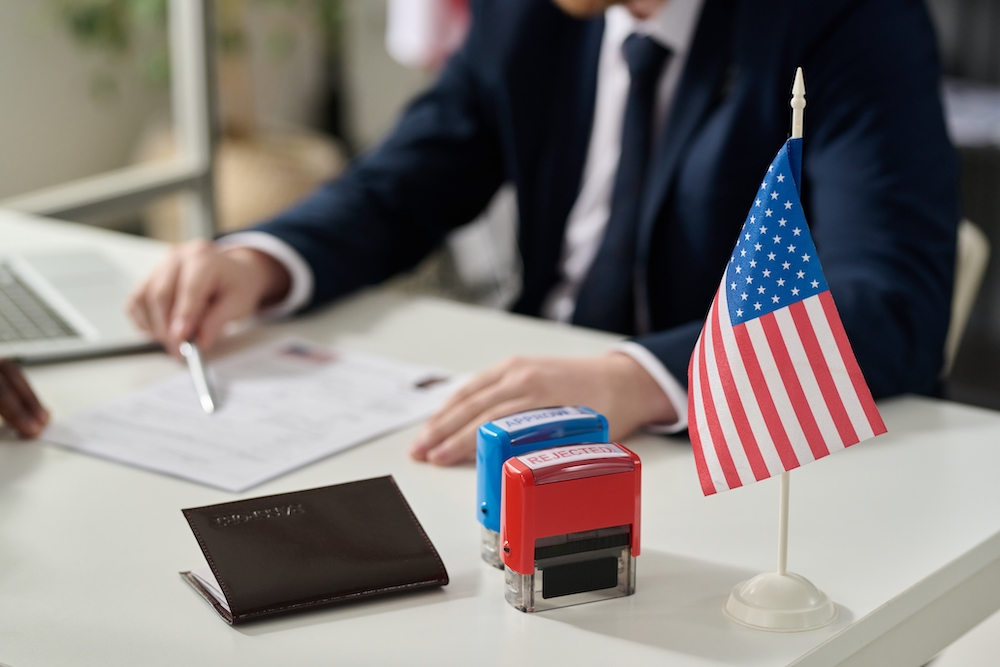Navigating the green card process can be daunting, given its many complex pathways and requirements. This complete green card application guide will show you how to get a green card to live in the United States.
Green cards are typically for immigrants, spouses, and students. You’ll learn about the different types of green cards and how to apply for them step by step. This guide has all the information you need to achieve permanent resident status.

What is a Green Card?
Types of Green Cards
Several paths exist for obtaining a green card. Understanding the type of green card that’s right for you is the first step in your application process.
Family-Sponsored Green Cards
Employment-Based Green Cards
Green cards through employment are available for individuals with specialized skills. They are also accessible for those who plan to invest significant capital in a U.S. business. The process can be lengthy and typically requires employer sponsorship.
Diversity Visa Program (Lottery) Green Cards
Many know the Diversity Visa Program as the green card lottery. It provides a way for individuals from eligible countries to move to the United States. It also provides a limited number of green cards through a random selection process.
Refugee or Asylee Green Cards
If you receive refugee status in the United States, you may qualify to apply for a green card. The term for this process is adjustment of status.
Other Special Green Card Application Categories
Several other categories exist for green cards.. These include the Violence Against Women Act (VAWA) self-petitioners, victims of human trafficking, and special immigrant juveniles.
Eligibility Criteria
Each type of green card has its own set of eligibility criteria. However, there are some general factors that apply to most applicants.
- The applicant must be eligible for an immigrant visa and be admissible to the United States.
- A petitioner, such as a family member or employer, must file a petition on the applicant’s behalf.
- The applicant must have a qualifying relationship with the petitioner. They also have the option to meet the criteria for the green card category they are applying under.
-
Unless waived, the applicant must hold an approved immigrant visa petition.
- The applicant must be eligible for adjustment of status in the United States.
How to Get a Green Card in the U.S. Without Marriage
- Employment-Based Immigration: This path includes different visas for individuals with extraordinary abilities (EB-1). Professionals with advanced degrees or exceptional abilities (EB-2). Finally, skilled or unskilled workers filling specific labor shortages (EB-3). An employer must sponsor the applicant and initiate the process by filing a petition with USCIS.
- Family Sponsorship: U.S. citizens and green card holders can sponsor relatives for green cards. Immediate relative visas cover spouses, parents, and unmarried children under 21 of U.S. citizens. These kinds of visas are unlimited. Additionally, there are family preference visas, which are limited and cover other family relations.
- Diversity Lottery: Many know this program as the green card lottery. It allocates up to 50,000 visas annually to individuals from countries with low immigration rates to the United States. Participants must apply during the specified registration period and meet basic education or work experience requirements.
- Investor Visa (EB-5): This program is for investors who can invest $500,000 or $1 million in a new U.S. enterprise. The investment should create at least ten full-time jobs. The investment amount varies depending on the economic status of the investment area.
- Refugee or Asylum Status: Those granted refugee or asylum status can apply for a green card. They are eligible to do so one year after their admission into the U.S.
- Special Immigrant Visas: Certain immigrants may apply for green cards. This includes those who have worked for the U.S. government abroad, religious workers, and other specified categories.
What is a Marriage-Based Green Card?
Understanding the Marriage-Based Green Card Application Process
The Marriage-Based Green Card lets a foreign national live and work in the U.S. permanently. The foreign national must marry a U.S. citizen or Lawful Permanent Resident (LPR).
The process begins with filing Form I-130 to establish the marriage’s validity. Successful applicants may proceed to adjust their status or undergo consular processing, depending on their current residence. You must complete consular processing at a consular office. The process includes thorough checks and an interview to confirm the marriage’s validity.
Conditional residency may apply, requiring further steps to remove conditions after two years. This pathway can eventually lead to U.S. citizenship.
For a detailed guide, visit the full article here.
How Much is it to Apply for a Green Card Through Marriage?
Navigating the financial aspect of obtaining a marriage-based green card is crucial for couples planning this route. The process involves several fees and potential additional costs that can vary depending on individual circumstances.
Initial Costs
- I-130 Filing Fee: This is a requirement to establish the marital relationship legally and currently costs $535.
- Adjustment of Status Fee (I-485): This fee applies if the spouse is already in the United States. The fee ranges from $1,130 to $2,270. The fee depends on factors such as age and whether the application is for a child under 14.
- Biometrics Fee: This $85 fee is mandatory for all applicants for the biometric services appointment.
Additional Expenses
- Legal Fees: While not mandatory, many opt for legal representation, which can significantly vary in cost.
- Translation Services: Necessary for any documents not in English.
- Travel Costs: If applicable, for the spouse living outside the U.S. to travel for the green card interview.
- Medical Examination Fees: Required for all applicants, with costs differing based on location and specific medical tests required.
- Affidavit of Support: This document proves the U.S. spouse can financially support the immigrant spouse.
Cost-Saving Tips
- DIY Application: Handling the application process without a lawyer, if confident.
- Fee Waivers: For eligible individuals, based on income or financial hardship, some fees might be waivable.
- Regular Checks: Keep up with the USCIS for any fee changes.
How to Get a Green Card Through Marriage/How to Get a Marriage Green Card
Obtaining a green card through marriage to a U.S. citizen or Lawful Permanent Resident (LPR) is a popular pathway. Non-U.S. individuals seeking permanent residency favor this pathway. The process is detailed and requires careful adherence to U.S. immigration laws to ensure success.
Key Requirements: The marriage must be legally valid and genuine, not just undertaken for immigration benefits. Both partners must meet all legal marriage requirements. Additionally, the marriage must be bona fide. This means the spouses enter into the marriage in good faith and not for circumventing immigration laws.
Green Card Categories: There are two primary categories through which one can apply:
- Immediate Relative of a U.S. Citizen: An annual cap on visas does not limit this category.
- Spouse of a Lawful Permanent Resident: This category is subject to annual visa caps. Applicants may face a waiting period for visa availability.
The Marriage Green Card Application Process:
- Filing the I-130 Petition: The U.S. citizen or LPR spouse must file this petition. Filing it with the U.S. Citizenship and Immigration Services (USCIS) proves the validity of the marriage.
- Adjustment of Status or Consular Processing: If the spouse is inside the U.S. they will adjust their status. If they are seeking a green card outside the U.S. they will undergo consular processing.
Supporting Documents: Important papers include proof of the petitioner’s citizenship or LPR status. It also includes the marriage certificate, proof of the end of any prior marriages, and financial documents, among others. These documents are to show the marriage is real.
Interview and Approval Process: Both spouses may have to attend an interview and be physically present. They will answer questions about their relationship to confirm its validity. Successful interviews will lead to the green card approval. However, it may be conditional and require further proof of the relationship after two years.
Rights and Responsibilities: A green card through marriage grants the right to live and work permanently in the United States. It also allows for travel in and out of the country. Eventually the green card holder may file the application for citizenship after the green card.
Navigating this process can be complex because of the meticulous documentation and strict adherence to legal procedures required. Many opt to consult with immigration attorneys to guide them through the process effectively.
For a more step-by-step guidance visit detailed resources like those provided by Immigration Vision.
Pathway to a Marriage-Based Green Card
Securing a marriage-based green card is a significant step for couples. This is where one partner is a U.S. citizen or a lawful permanent resident (LPR). The process includes several crucial stages, from legally recognizing the marriage to the final green card interview.
Legal Recognition of Marriage
Filing the I-130 Petition
The U.S. citizen or LPR spouse must file an I-130 Petition for Alien Relative. This form initiates the green card process by establishing the marital relationship officially. Supporting documents, such as birth certificates and passport-style photos of both spouses, are also necessary during this stage.
Visa Number Availability
For spouses of LPRs, obtaining a visa number might involve a waiting period. This is because of annual limits, during which maintaining legal status in the U.S. is essential. Immediate relatives of U.S. citizens do not face this delay.
Adjustment of Status vs. Consular Processing
Spouses seeking green cards who reside in the U.S. will adjust their status using Form I-485. If they are outside the U.S. they will undergo consular processing at a U.S. embassy or consulate. Both processes require comprehensive documentation and interviews.
Conditional Green Card
Spouses married less than two years at the time of approval receive a conditional green card valid for two years. Near the end of this period, you must file a joint petition (Form I-751 or I-829). This is to establish the ongoing credibility of the marriage and remove the conditions.
Green Card Interview Preparation
The green card interview is a critical step where couples must verify their marriage is credible. Preparation includes reviewing application details, gathering further documents, and practicing responses to potential questions about the relationship.
Ensuring Compliance and Understanding Rights
Throughout the process, it is vital to comply with all immigration laws and understand the rights afforded by the green card. This includes the ability to live, work, and travel freely within the United States. Legal advice may be beneficial to navigate this complex process smoothly.
Applicants can enhance their chances of successfully obtaining a marriage-based green card by preparing for each stage. This can mark a pivotal moment in their lives and relationships.
Green Cards for Second Marriages
Securing a green card for a spouse in a second marriage generally follows similar steps to first marriages. However, there is particular attention to proving the marriage’s validity. If you’ve previously sponsored a former husband or wife, this alone won’t disqualify you. Nevertheless, expect USCIS to closely examine your application.
Securing Your Green Card in a Second Marriage:
1: File the I-130 petition to establish the spousal relationship.
2: Provide evidence of a bona fide marriage through documents like joint bank accounts and lease agreements.
3: Attend a USCIS interview to verify the validity of the marriage.
4: If needed, apply for a waiver because of complications like recent divorce or death of a previous spouse.
What Does a Green Card Look Like?
What a Green Card Looks Like: A Visual Guide
A U.S. Green Card (or Permanent Resident Card), symbolizes the bearer’s lawful permanent residency in the United States. The front of the card displays the holder’s photo, name, country of birth, birth date, and a unique USCIS number.
The card features a green, intricately detailed background designed to prevent tampering. Security features include a magnetic strip and barcode on the back for identity verification. Enhancements such as RFID tags and holographic images improve security and prevent counterfeiting.
What is the Green Card Lottery?
Understanding the Green Card Lottery
The Green Card Lottery (or Diversity Immigrant Visa Program), is an annual initiative by the U.S. government. It aims to diversify the immigrant population in the United States through its design. It selects applicants from countries with historically low rates of immigration to the United States. Each year, this lottery system makes approximately 50,000 visas available.
Key Points of the Green Card Lottery:
- Eligibility: To participate, you must be a native of an eligible country. The country must also have low rates of immigration to the United States.
- Additional Requirements: The individual seeking a green card must have at least a high school education or its equivalent. You may also have two years of work experience in an occupation. This occupation must require at least two years of training or experience.
- Green Card Lottery Application Process: The lottery registration is typically open for a limited period. It opens each year in the fall and it’s crucial to apply during this window. The application process involves submitting an online form with personal information and a digital photo.
- Selection and Visa Application: Random selection determines the winners. If chosen, it does not guarantee a visa, but winners may then apply for one. The process involves submitting further documentation and attending an interview at a U.S. embassy or consulate.
- Financial and Legal Preparedness: It’s important for winners to demonstrate that they will not become public charges. They must demonstrate they are able manage the substantial costs associated with the immigrant visa application and relocation.
Importance of Compliance and Timing:
Applying for the lottery requires careful attention to detail and adherence to the registration timeline. Errors or missed deadlines can disqualify an applicant, and there are strict rules against fraudulent applications.
Awareness and Alternatives:
While the lottery offers a unique opportunity for U.S. residency, it’s also a target for scams. Potential applicants should only use the official website for their application. They should be wary of any service that charges a fee for entering the lottery.
Besides the lottery, there are other pathways to U.S. immigration. This includes family-based and employment-based visas. These might be more appropriate for some individuals.
For more detailed information, you can refer to the comprehensive guide on the Diversity Visa Program at Immigration Vision.
How to Apply for the Green Card Lottery
Applying for the Green Card Lottery: A Step-by-Step Guide
The Green Card Lottery offers a unique opportunity to individuals aspiring to become lawful permanent residents of the U.S. without family or employment sponsorship. Many know the Green Card lottery as the Diversity Immigrant Visa Program. This program makes available 55,000 visas to individuals from countries with historically low rates of immigration to the U.S.
Here’s a concise guide to navigate through the application process:
- Confirm Your Eligibility: First, ensure you are from an eligible country with low U.S. immigration rates. You should have either a high school education or two years of qualifying work experience.
- Prepare Required Documentation: You’ll need to gather necessary documents. This includes your passport, educational or work experience records, and a digital photograph that meets specific requirements.
- Apply Online: Submit the application through the official U.S. Department of State website. During a designated period, typically in the fall, applicants submit their application. Applicants must complete the process online, and it is free of charge.
- Ensure Accuracy: Submit accurate personal and eligibility information. Discrepancies can lead to exclusion.
- Save Your Confirmation Number: After applying, you’ll receive a confirmation number. Keep this safe as it is essential for checking your application status.
- Check Lottery Results: The U.S. Department of State typically announces results in the spring following your application. If selected, you will need to provide further documentation and attend interviews.
The Green Card Lottery application is an opportunity that requires careful attention to detail and timely action. For more comprehensive details on the application process, visit the official DV Lottery website. We recommend consulting legal experts if needed.
Applying for a Green Card: Key Steps Explained
Applying for a green card in the United States can be a complex process, involving several important steps. Initially, it’s crucial to determine your eligibility. This may depend on family ties, employment, refugee or asylee status, or other special categories.
For certain applicants like spouses of U.S. citizens, the initial green card might be conditional. This means your conditional green card may require further steps to remove conditions. Given the complexity and significant documentation involved, it’s advisable to seek legal advice.
For a comprehensive breakdown of each step, visit How to Apply for a Green Card: A Comprehensive Guide.
How to Apply for a Green Card
Applying for a Green Card: Key Steps and Considerations
Your green card application involves understanding your eligibility, managing complex forms, and navigating through procedural steps. Eligibility categories include family, employment, special immigrant status, refugees, and victims of crime.
Here are the key forms you need for a green card application:
- Form I-130: For family-based immigration, used to petition for a green card on behalf of a family member.
- Form I-140: Used by prospective immigrants eligible through employment to petition for an immigrant visa.
- Form I-589: Necessary for asylum seekers to apply for asylum and withholding of removal.
- Form I-360: Covers a range of special immigrant categories, including religious workers and certain physicians.
The application process may involve adjustment of status if you’re in the U.S., or consular processing if abroad. Applicants must submit thorough documentation and pay applicable fees. Interviews and maintaining the conditions of the green card are crucial following approval. If denied, options include appealing or reassessing your eligibility (Immigration Vision).
What to Do if Immigration Authorities Deny Your Green Card Application
Receiving a denial can be heartbreaking, but it’s not necessarily the end of the line. You often have the option to appeal the decision or to reapply, typically with more thorough documentation and reasoning.
Seek Legal Advice:
Reassess Your Eligibility: A denial may be because you are in an unsuitable category. It could also be an error with the application process. Once you ascertain the reason for the denial of your application, you can take steps to rectify the situation.
How Long Does It Take to Get a Green Card?
Green Card Application Processing Times
Applying for a U.S. green card involves variable wait times influenced by several factors. These include the immigrant visa category, the applicant’s country of origin, overall applicant volume, and changes in immigration policies.
Immediate relative categories like those for spouses of U.S. citizens typically experience shorter wait times. The wait time ranges from a few months to just over a year. In contrast, preference categories may have much longer waits because of annual caps and backlogs.
The U.S. Department of State’s monthly Visa Bulletin and the USCIS website are valuable resources. You can use them to track specific wait times and application backlogs. Tips for managing the wait include maintaining communication with your attorney or USCIS. You can also stay informed about immigration changes, and being well-organized with your application documents (Immigration Vision).
Proving Your Income for a Child’s Green Card
When applying for a green card for your child, demonstrating your financial capability is crucial. You must file an Affidavit of Support and show that your income is at least 125% above the Federal Poverty Guidelines. If your income is insufficient, consider assets like savings and real estate.
All financial details must be well-documented, and discrepancies can delay or derail the application. For complex cases, consulting with immigration lawyers or financial experts can be beneficial to navigate the requirements effectively (Immigration Vision).
What to Do If You Lose Your Green Card
Losing a green card can be stressful, but there is a clear process for replacement. First, verify if you’ve truly lost it, and then report the loss to USCIS or possibly local law enforcement if stolen. File Form I-90 online or by mail with necessary documents like a government-issued ID and recent photos.
You will have an appointment to verify your identity and background. Post-appointment, USCIS processes the application and will reissue the green card. Keep copies of all documents and monitor your application status through the USCIS website. Act quickly to minimize impact on travel or proof of residency (Immigration Vision).



